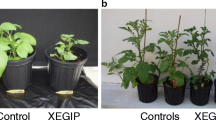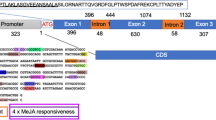Abstract
Xanthomonas campestris pv. vitians, a pathogen of lettuce, elicits a hypersensitive response within 12 hours of inoculation into Brassica leaves, characterized by tissue collapse, loss of membrane integrity, vein blockage and melanin production. In contrast, the compatible pathogen, X. c. pv. campestris, has no visible effects on leaves for 48 hours, after which inoculated areas show chlorosis which eventually spreads, followed by rotting.
mRNA was prepared from leaves inoculated with suspensions of both pathovars or with sterile medium up to 24 hours following inoculation. In vitro translation of total and poly A+ RNA in rabbit reticulocyte lysate in the presence of 35S methionine followed by separation of the polypeptide products by 2D-PAGE, allowed comparison of the effects of these treatments on plant gene expression. Major changes in gene expression were observed as a consequence of the inoculation technique. In addition, after inoculation with X. c. vitians, up to fifteen additional major polypeptides appeared or greatly increased by four hours. Some of these had disappeared by nine hours and several more had appeared. No major polypeptides disappeared or decreased greatly in intensity following inoculation with X. c. vitians.
Similar content being viewed by others
References
Bell AA: Biochemical mechanisms of disease resistance. Ann Rev Pl Physiol 32: 21–81 (1981).
Bolwell GP, Robbins MP, Dixon RA: Metabolic changes in elicitor treated bean cells: Enzymatic responses associated with rapid changes in cell wall components. Eur J Biochem 148: 571–578 (1985).
Burland TG, Gull K, Schedl T, Boston RS, Dove WF: Cell type-dependent expression of tubulins in Physarum. J Cell Biol 97: 1852–1859 (1985).
Chamberlain JP: Fluorographic detection of radioactivity in polyacrylamide gels with the water-soluble fluor, sodium salicylate. Anal Biochem 98: 132–135 (1979).
Chua N-H, Bennoun P: Thylakoid membrane polypeptides of Chlamydomonas reinhardtii: wild-type and mutant strains deficient in photosystem II reaction centre. Proc Natl Acad Sci 72: 2175–2179 (1975).
Cook DR, Robeson DJ: Active resistance of cabbage (Brassica oleracea) to Xanthomonas campestris pv. carotae and protection against the causal agent of black rot X. campestris pv. campestris, by co-inoculation. Physiol Pl Path 28: 41–52 (1986).
Cornellissen BJC, Hooft van Huijsduijnen RAM, Bol JF: A tobacco mosaic virus-induced tobacco protein is homologous to the sweet-tasting protein thaumatin. Nature 321: 531–532 (1986).
Covey SN, Grierson D: Subcellular distribution and properties of poly(a)-containing RNA from cultured plant cells. Eur J Biochem 63: 599–606 (1976).
Cramer CL, Bell JN, Ryder TB, Bailey JA, Schuch W, Bolwell GP, Robbins MP, Dixon RA, Lamb CJ: Co-ordinated synthesis of phytoalexin biosynthesis enzymes in biologically-stressed cells of bean (Phaseolus vulgaris L.). EMBO J 4: 285–289 (1985).
Daniels MJ, Barber CE, Turner PC, Sawczyc MK, Byrde RJW, Fielding AH: Cloning of genes involved in pathogenicity of Xanthomonas campestris pv campestris using the broad host range cosmid pLAFR1. EMBO J 3: 3323–3328 (1984).
Daniels MJ, Collinge DB, Dow JM, Osborn AE, Roberts IN: Molecular biology of the interaction of Xanthomonas campestris with plants. Plant Physiol Biochem (in press).
Davies JW: Translation of plant virus ribonucleic acids in extracts from eukaryotic cells. In: Hall TC, Davies JW (eds) Nucleic Acid in Plants, Vol. 2, pp 111–149. Florida: CRC Press (1979).
Dennis ES, Gerlach WL, Pryor AJ, Bennetzen JL, Inglis A, Llewellyn D, Sachs MM, Ferl RJ, Peacock WJ: Molecular analysis of the alcohol dehydrogenase (adhI) gene of maize. Nucl Acids Res 12: 3983–4000 (1984).
Dixon RA, Dey PM, Lamb CJ: Phytoalexins: enzymology and molecular biology. Adv Enz 55: 1–135 (1983).
Dye DW, Lelliot RA: Genus Xanthomonas. In: Buchanan RE, Gibbons NE (eds) Bergey's Manual of Determinative Bacteriology, 8th edn., pp 243–249. Baltimore, Maryland: Williams and Watkins (1974).
Esquerré-Tugayé M-T, Mazau D, Pelissier B, Roby D, Toppan A: Elicitors and ethylene trigger defense responses in plants. In: Fuchs Y, Chalutz E (eds) Ethylene: Biochemical, Physiological and Applied Aspects, pp 217–218. The Hague: Martinus Nijhoff (1984).
Freeling M, Birchler JA: Mutants and variants of the alcohol dehydrogenase-1 gene in maize. In: Setlow JK, Hollaender A (eds) Genetic Engineering 3, pp 223–263. New York and London: Plenum Press (1981).
Fristensky B, Riggleman RC, Wagoner W, Hadwiger LA: Gene expression in susceptible and disease resistant interaction of peas induced with Fusarium solani pathogens and chitosan. Physiol Plant Pathol 27: 15–28 (1985).
Hadwiger LA, Wagoner W: Electrophoretic patterns of pea and Fusarium proteins synthesized in vitro or in vivo which characterise the compatible and incompatible interactions. Physiol Plant Pathol 23: 153–162 (1983).
Hahlbrock K, Chappell J, Huhn DN: Rapid induction of mRNAs involved in defense reactions in plants. Ann Proc Phytochem Soc Eur 23: 171–182 (1984).
Hooft van Huijsduijnen RAM, van Loon LC, Bol JF: cDNA cloning of six mRNAs induced by TMV infection of tobacco and a characterisation of their translation products. EMBO J 5: 2057–2061 (1986).
Jackson RJ, Hunt T: Preparation and use of nucleasetreated rabbit reticulocyte lysates for the translation of eukaryotic messenger RNA. Meth Enz 96: 50–74 (1983).
Jen G, Thach RE: Inhibition of host translation in encephalomyocarditis virus-infected L cells: a novel mechanism. J Virol 43: 250–261 (1982).
Keen NT, Ersek T, Long M, Bruegger B, Holliday M: Inhibition of the hypersensitive reaction of soybean leaves to incompatible Pseudomonas spp. by blasticidin S, streptomycin or elevated temperature. Physiol Plant Pathol 18: 325–337 (1981).
Keen NT, Staskawicz BJ: Gene cloning as an approach to understanding specificity in plant-pathogen systems. In: Dugger WM, Bartnicki-Garcia S (eds) Structure, Function and Biosynthesis of Plant Cell Walls, pp 344–358. Proc 7th Symposium of Botany, University of California at Riverside (1984).
Klement Z: Hypersensitivity. In: Mount MS, Lacy GH (eds) Phytopathogenic Prokaryotes, Vol. 2, pp 149–177. New York and London: Academic Press (1982).
Kuan T-L, Minsavage GV, Schaad NW: Aerial dispersal of Xanthomonas campestris pv campestris from naturally infected Brassica campestris. Plant Disease 70: 409–413 (1986).
Laemmli UK: Cleavage of structural proteins during assembly of the head of bacteriophage T4. Nature 227: 680–685 (1970).
Manners JM, Davidson AD, Scott KJ: Patterns of post-infectional protein synthesis in barley carrying different genes for resistance to the powdery mildew fungus. Plant Molec Biol 4: 275–283 (1985).
Martin CR, Northcote DH: Qualitative and quantitative changes in mRNA of castor beans during the initial stages of germination. Planta 151: 189–197 (1981).
Mauch F, Hadwiger LA, Boller T: Ethylene: symptom, not signal for the induction of chitinase and β-1,3-glucanase in pea pods by pathogens and elicitors. Plant Physiol 76: 607–611 (1984).
O'Farrell PH: High resolution two-dimensional electrophoresis of proteins. J Biol Chem 250: 4007–4021 (1975).
Osbourn AE, Barber CE, Daniels MJ: Identification of plant-induced genes of the bacterial pathogen Xanthomonas campestris pathovar campestris using a promoter-probe plasmid. EMBO J 6: 23–28 (1987).
Riggleman RC, Fristensky B, Hadwiger LA: The disease resistance response in pea is associated with increased levels of specific mRNAs. Plant Molec Biol 4: 81–86 (1985).
Roberts IN, Dow JM, Lum K-Y, Scofield G, Barber CE, Daniels MJ: (manuscript submitted).
Shirras AD, Northcote DH: Molecular cloning and characterisation of cDNAs complementary to mRNAs from wounded potato (Solanum tuberosum) tuber tissue. Planta 162: 353–360 (1984).
Slusarenko AJ, Longland A: Changes in gene activity during expression of the hypersensitive response in Phaseolus vulgaris cv. Red Mexican to an avirulent race 1 isolate of Pseudomonas syringae pv. phaseolicola. Phys Molec Plant Pathol 29: 79–94 (1986).
Turner PJ, Barber CE, Daniels MJ: Behaviour of the transposons Tn5 and Tn7 in Xanthomonas campestris pv. campestris. Mol Gen Genet 195: 101–107 (1984).
Turner PJ, Barber CE, Daniels MJ: Evidence for clustered pathogenicity genes in Xanthomonas campestris pv campestris. Molec Gen Genet 199: 338–343 (1985).
Van Loon LC: Pathogenesis-related proteins. Plant Mol Biol 4: 111–116 (1985).
Wagoner W, Loscke DC, Hadwiger LA: Two dimensional electrophoretic analysis of in vivo and in vitro synthesis of proteins in peas inoculated with compatible and incompatible Fusarium solani. Physiol Plant Pathol 20: 99–107 (1982).
Weber K, Osborn M: The reliability of molecular weight determination by dodecyl sulphate-polyacrylamide gel electrophoresis. J Biol Chem 244: 4406–4412 (1969).
Williams PH: Black rot: a continuing threat to world crucifers. Plant Disease 64: 736–742 (1980).
Author information
Authors and Affiliations
Rights and permissions
About this article
Cite this article
Collinge, D.B., Milligan, D.E., Dow, J.M. et al. Gene expression in Brassica campestris showing a hypersensitive response to the incompatible pathogen Xanthomonas campestris pv. vitians . Plant Mol Biol 8, 405–414 (1987). https://doi.org/10.1007/BF00015818
Received:
Revised:
Accepted:
Issue Date:
DOI: https://doi.org/10.1007/BF00015818




